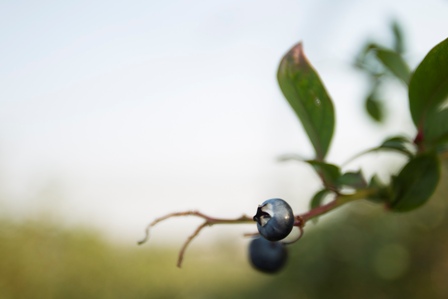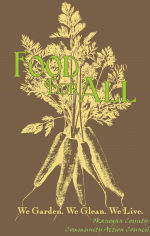
OCCAC started an on-site demonstration garden located at the Okanogan food bank and distribution center in 2009. Successive gardens have been planted, maintained and harvested through 2012, with plans for continual use of this educational tool and fresh produce source for the adjacent food bank. Supplying a direct source of gleaned produce to a specific food bank is a great way to build a produce recovery program of any scale. Below are a few step-by-step recommendations based off of the fourth season at OCCAC’s on-site demonstration garden.
Location
OCCAC’s on-site model:
-
Easy Access to food bank and clientele. Potential volunteer source is your clients. Provide access to the garden during food bank hours with a staff or volunteer present to answer questions and for educational purposes.
-
Instant publicity. A visual demonstration of how to grow food generates interest to all who visit the food bank and adjacent areas. The on-site approach provides an educational tool at your host site.
-
Guaranteed source of produce. A designated source of fresh produce to the food bank keeps produces recovery fresh, local and reliable.
-
Educational / Experimental projects:
-
In 2012, OCCAC grew pepper plants in straw bales, which incidentally, also grew oyster mushrooms. In a more mycophylic culture, these oyster mushrooms would not only be a food source, but could also be redistributed, and cultured in the homes of food bank clients as a continued food source.
-
The cold frame was a great success. The construction and materials were simple [wood, PVC, screws, heavy clear plastic], and the structure extended the growing season 6-8 weeks. While displaying the garden at conferences, and doing general outreach, the cold frame was an attractant for new and experienced gardeners.
-
In 2012, OCCAC also added two compost bins constructed out of wooden pallets, to accompany the steel drum compost tumbler as active demonstrations creating compost.
-
Trellising techniques were also used for melons, peas, and tomato plants.
Scale
Decide on amounts, type, size, etc. Pick a baseline of “how much” produce you want to grow and fit the size of garden to your needs. Also determine which “style” of gardening to utilize. For example, OCCAC grows food for one food bank, uses twelve apple bins filled with a dirt/compost/manure blend and utilizes the square-foot method of gardening with organic practices. Hashing out these details prior to any further planning is essential. Identify the necessary materials and supplies necessary for the correct location and scale of the project. Identify potential donations to project. Designate the management of the garden to staff, volunteers, lead gardeners or groups of unskilled volunteers. Figuring out the specific order of operation will help down the line.
 Work parties
Work parties
For the project construction, building as well as planting events, can help generate community interest in the project. A maintenance schedule should also be arranged in advance. Assign proper staff hours and/or volunteer hours to upkeep, maintenance, replanting etc.
Harvesting Schedule
Coordinate with food bank distribution schedule and/or secure a convenient storage location with a cooler available.
Results
Develop a baseline goal for the project and how it will impact the food bank. For example, “increase fresh produce by one serving” or a survey of food bank clientele opinions on access to fresh produce before and after the season are used at OCCAC. These baselines can be utilized for larger scale projects down the road or for future grants.
End of Season
Review surveys, production amounts, garden plans, successes, failures and incorporate all information into future planning.
Home Garden Construction
OCCAC planted nine gardens this past spring, and one garden midsummer, as part of the G.G.G.T (Gleaning, Gardening and Growing Together) program. The gardening component of the grant is intended to provide an accessible gardening experience to first-time gardeners, and provide inspiration and education for newly developing home gardeners. While community gardens are successful elsewhere, a history of failed attempts at community gardens and the geography of this region dictated a different approach. The rural setting and travel required to access food banks, grocery stores or farmable land vary throughout the region. By building gardens in the families’ backyards, similar to the victory gardens during WWII, food security and access to fresh produce are literally outside the doorstep for low-income families. In times of food insecurity, what would you rather have in your front yard, grass, or a vegetable patch?
OCCAC’s Square Foot Gardens were 8’x4’ foot raised bed gardens, complete with all materials, seeds, plants and irrigation elements necessary to make the gardening process as user-friendly as possible. Through OCCAC grant sponsors and collaborators, gardens were planted countywide. Below are 10 points to consider before starting a home garden construction program.
-
Target Your Goals
-
Recipient population - do they have particular needs, like senior citizens, low-income families or Spanish speaking?
-
Metrics - measures of success like, “increase access to produce by 2-3 servings weekly.”
-
Education - skills training, nutrition, construction.
-
Develop partnerships specific to home garden construction. Pursue co-grantees or supporting organizations or find a self-sustainable approach. Clearly define a budget to dictate the amount and type of home gardens your agency provides.
-
Divide budget to amount of desired gardens for program based on cost-for-cost estimates on a full garden build and planting. Choose type of garden and materials. Look for donation sources for materials like plant starts, manure, seeds, etc.
-
Define selection criteria for recipients, educators/mentors, volunteer groups. OCCAC applications included a “needs survey.” Also considered were general criteria requirements, rental versus ownership information. This information was compiled and used to develop a rank-based system that took into account the date applied and proximity to available mentors. Site visits were used to attain important information in the process of deciding on recipients. For example, you need to see if a garden is even feasible at the families’ dwellings. Other factors considered included availability of a water source and seasonal versus permanent housing. A similar screening was done for the mentors and volunteer groups. Inform all parties of their roles and the overarching goals of the project before they commit.
-
Campaign for applicants. Utilize media and program outreach venues. Review applicants based on pre-determined criteria.
-
Select applicants and determine schedules. Give applicants two date options to commit to a garden installation/planting and then schedule based on their preference. Keep in mind that if a recipient can’t commit to the build they may not commit to the entire growing season. For example, an applicant family failed to be at the garden build on the assigned date so a second date was made. A month after install, a site-check by the assigned mentor found the garden neglected.
-
Provide pre-season engagement for applicants. A lead-up to the gardening season was not done this year but is built into OCCAC’s grant for next year. Assessing families before the gardening season can help “weed out” commitment levels and can help determine what skill level the family has at present time prior to the program. Pre-season engagement was used via a mentor-training workshop teaching the agency’s selected gardening methods.
-
 Schedule, Schedule, Schedule! Scheduling was the biggest challenge faced this season at OCCAC. A late growing season, due to the long wet spring weather, plus multiple recipient cancellations led to a back-log of the garden installations and plantings. Pre-determine dates and limit recipients/volunteers to two options and stick to them no matter the weather. Assure materials are on-hand prior to assigned dates.
Schedule, Schedule, Schedule! Scheduling was the biggest challenge faced this season at OCCAC. A late growing season, due to the long wet spring weather, plus multiple recipient cancellations led to a back-log of the garden installations and plantings. Pre-determine dates and limit recipients/volunteers to two options and stick to them no matter the weather. Assure materials are on-hand prior to assigned dates.
-
Growing season tracking and site visits are recommended to help recipients succeed. OCCAC partnered with individual mentors as advocates for the project after the builds. The end-of-season should include surveys, reviews and comments from all groups to incorporate into the next year of gardening and for measuring grant requirements of the program.
-
Review the program and begin strategic planning for the next season.
Low- Cost Garden Education Options
-
The sheet mulching method listed above would work well anywhere that there are a lot of compostable materials. Composting is absolutely essential, and scrap wood / metal / stone is filling up landfills everywhere, and can be used for raised bed construction.
-
Seeds can be donated or collected. Solicit donation requests toward seed companies for last year’s unsold product, and then save the seeds from the plants that are grown.
-
Trees or shrubs can be started through localized collection / identification and propagation techniques. For instance, if a person wanted a local dogwood shrub, and they knew that dogwood shrubs grew next to the river, and they went down to the river, identified a dogwood shrub, got a branch cutting, set it in water with some root hormone from a local willow cutting, established roots, and put it in the ground – that person could have a willow tree and a dogwood tree by the end of their experiment; at no cost.
-
Build deep healthy soil, and use water conservation techniques. To experience an outline of these ideas, please examine the video “Greening the Desert”, a video about using permacultural gardening techniques to make an oasis on the salt beds of the Dead Sea.
-
The idea is that any family or school can take these actions if they want to, and that cost is not an inherently prohibitive aspect of garden creation, and consequentially food security.
Sustainable Futures
Each of the following methods are self-replicating “pass it on” types of food security options:
-
 Chickens lay eggs. Eggs become more chickens. More chickens lay more eggs.
Chickens lay eggs. Eggs become more chickens. More chickens lay more eggs.
-
Why are Food Banks still giving away eggs, instead of live chickens? Find a human with a chicken, or if you live in a city, consider partnering up with a neighbor who has room for chickens - or be assertive, and tell your local municipality that their laws are prohibiting you from sustainabiliy feeding your family.
-
Vermiculture is the most inexpensive and efficient, all season method of composting. Composting means a healthy garden. Healthy gardens produce food.
-
Why don’t Food Banks distribute worms to every household?
-
Once a tree, shrub, plant is established, it produces either seed, shoots, bulb, or some kind of cutting that is capable of reproducing itself.
-
Save Seeds, and be involved with plant starts, as opposed to asking for seeds and asking for plant starts. The difference is being involved in the producer work, as opposed to scavenging the current seed / plant start economy.
-
Mushrooms are edible, and can be cultivated at home, using the Stem Butt Technique. New mushrooms create new stem butts, which means new people can be cultivating these food sources.
-
Why don’t food banks distribute stem butts from edible local mushrooms?
If the above listed concepts and those similar to them, were to be utilized and embraced, the number of food bank clients in need would decrease dramatically. Why isn’t this happening, and what can be done to address that issue?

 Chickens lay eggs. Eggs become more chickens. More chickens lay more eggs.
Chickens lay eggs. Eggs become more chickens. More chickens lay more eggs.
